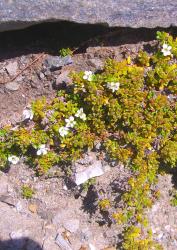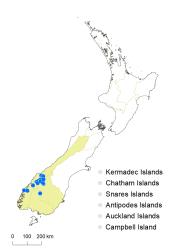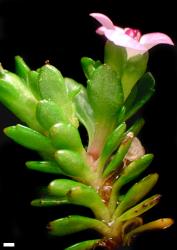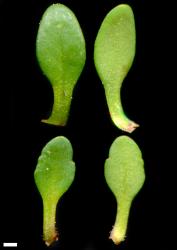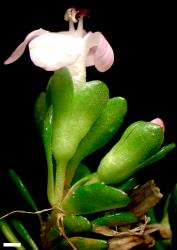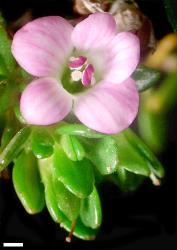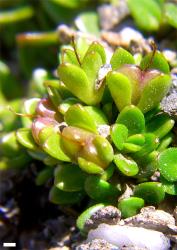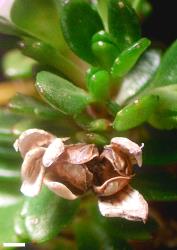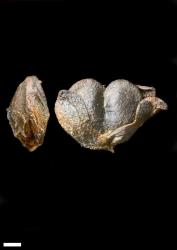- ≡ Parahebe planopetiolata (G.Simpson & J.S.Thomson) W.R.B.Oliv., Rec. Domin. Mus. 1: 229 (1944) – as plano-petiolata
- = Veronica muelleri Buchanan, Trans. & Proc. New Zealand Inst. 14: 351 (1882) nom. illeg., non Veronica muelleri Vest ex Schrank 1824 – as müelleri
- ≡ Parahebe muelleri W.R.B.Oliv., Rec. Domin. Mus. 1: 229 (1944) nom. nov. pro Veronica muelleri Buchanan 1882
Mat-forming sub-shrub to 0.05 m tall. Stems prostrate, sometimes rhizomatous, eglandular-pubescent or glabrous; hairs bifarious to uniform. Leaf bud indistinct; leaves separating while very small, opposite-decussate, erecto-patent to spreading; lamina sub-coriaceous, elliptic, oblong, oblanceolate, narrowly rhomboid, deltoid, or orbicular (rarely), 2–10 mm long, 1–6 mm (rarely to 10 mm) wide, glossy green above, dull pale green or purplish beneath, veins not evident or midrib faint; surfaces glabrous; margin glabrous or ciliate on petiole only; shallowly crenate or sometimes entire, teeth in 0–3 pairs; apex obtuse to rounded; base cuneate (rarely truncate); petiole 1–5 mm long. Inflorescence lateral, usually a pair of flowers or sometimes a solitary bibracteate flower, 5–8 mm long; peduncle 1–2 mm long, all bisexual; bracts opposite, spathulate to obovate, > pedicels; pedicels erecto-patent, sometimes incurved at fruiting, 1–7 mm long, glabrous. Calyx lobes 4, or sometimes small 5th lobe present, obtuse, sub-equal, 3.5–7.0 mm long, glabrous. Corolla 7–9 mm diameter; tube white and greenish, 2–4 mm long, < calyx, glabrous; lobes 4 or 5 by division of posterior lobe, white, rarely pink or purplish, erecto-patent, sub-equal, elliptic to obovate, oblong, orbicular, or rhomboid, 2.5–5.5 mm long, rounded; nectar guides absent or very faint, pink. Stamen filaments white, 1.5–2.5 mm long; anthers pink to magenta. Style glabrous, 2.5–3.5 mm long. Capsules angustiseptate, emarginate or didymous, glabrous, 3–4 mm long, 4–5 mm at widest point. Seeds ellipsoid or obovoid, flattened, smooth, pale brown, 0.8–1.1 mm long.
V. planopetiolata plants are usually placed in the snow hebe group. They might be confused with V. zygantha and V. colostylis. V. zygantha plants are more lax-growing, softly woody sub-shrubs with broader, more rounded and shallowly toothed leaves; their stems and inflorescences usually have short antrorse hairs. V. colostylis plants are lax or sometimes compact sub-shrubs; their narrower leaves have entire margins, and they have more flowers per inflorescence and longer peduncles and pedicels, their capsules are less strongly flattened, and the seeds are smaller (0.5–0.8 mm long).
South Island: Westland (in the south, mostly east of the main divide), Otago (western parts), Southland (Eyre Mountains), Fiordland (Mt McPherson, Lake Wapiti).
Alpine scree, moraine, fell-field, and cliffs. Recorded elevations range from 1220 to 1769 m.
Flowers: January–March; fruits: January–April, persisting longer.
2n = 84 (Hair 1970, as Parahebe planopetiolata var. planopetiolata).
Veronica planopetiolata is classified in V. subg. Pseudoveronica sect. Hebe but not currently assigned to any informal group (Albach & Meudt 2010). In molecular studies, Veronica planopetiolata did not cluster clearly with either the speedwell hebes or the snow hebes (Albach & Meudt 2010). Its tetraploid chromosome number suggests an allopolyploid origin, which might explain the lack of resolution in its phylogenetic position.
Plants collected from Minaret Burn headwaters (Barkla s.n., WELT SP093503) west of Lake Wānaka, are different from others in having broadly deltoid to orbicular lamina, truncate at the base, and the margin crenate with usually one pair of incisions.



